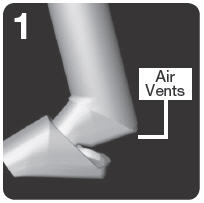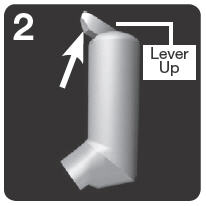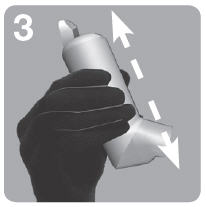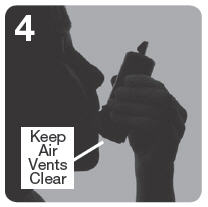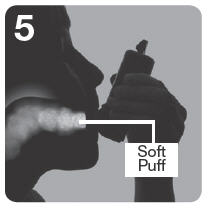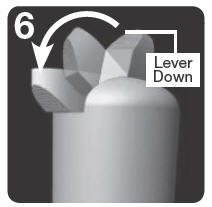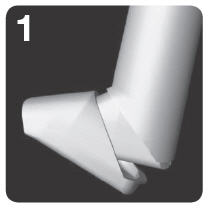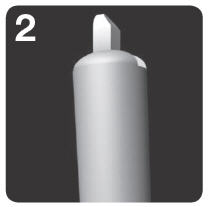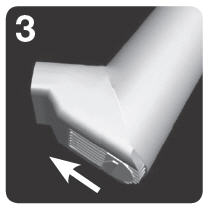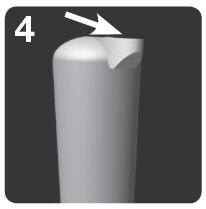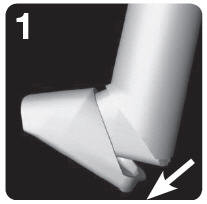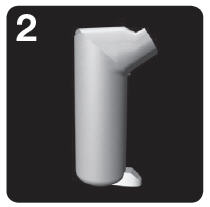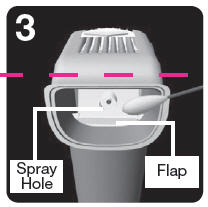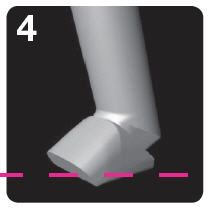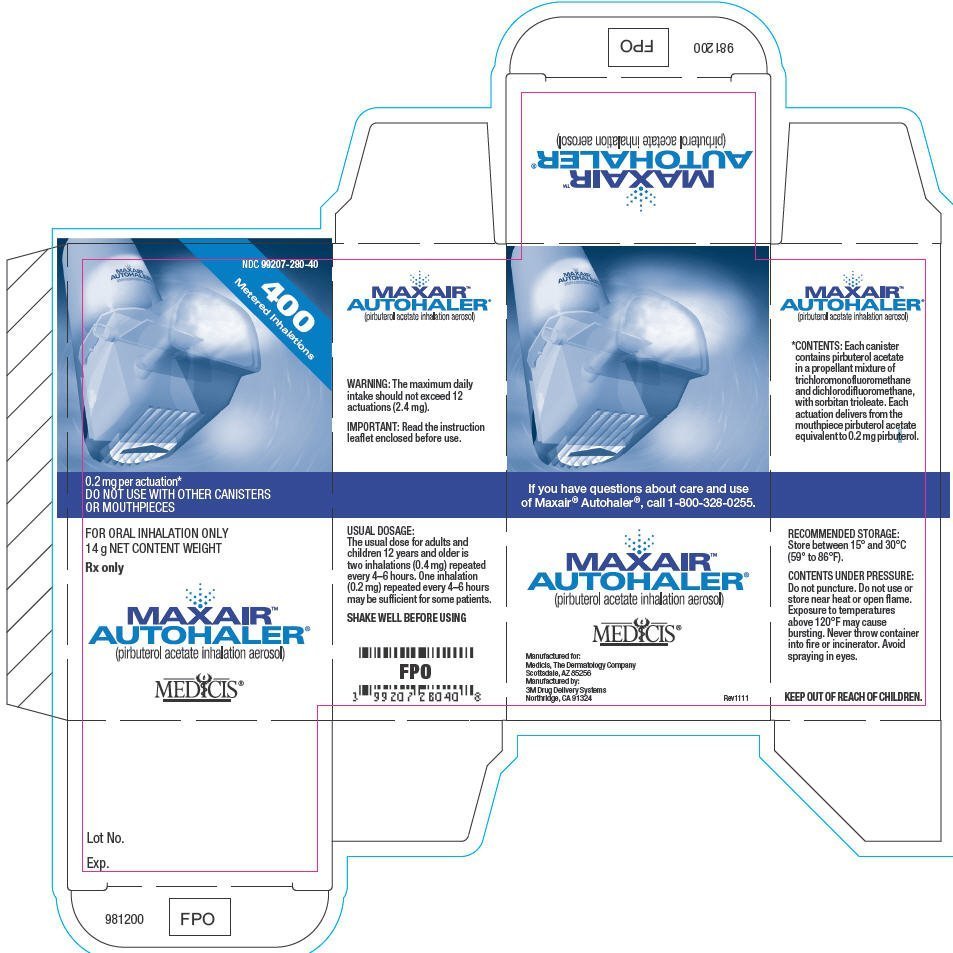Maxair Autohaler: Package Insert / Prescribing Info
Package insert / product label
Generic name: pirbuterol acetate
Dosage form: inhalation aerosol
Drug class: Adrenergic bronchodilators
Medically reviewed by Drugs.com. Last updated on Mar 25, 2024.
On This Page
Note: The indented statement below is required by the Federal Government's Clean Air Act for all products containing or manufactured with chlorofluorocarbons (CFCs).
This product contains trichloromonofluoromethane and dichlorodifluoromethane, substances which harm the environment by destroying ozone in the upper atmosphere.
Your physician has determined that this product is likely to help your personal health. USE THIS PRODUCT AS DIRECTED, UNLESS INSTRUCTED TO DO OTHERWISE BY YOUR PHYSICIAN. If you have any questions about alternatives, consult with your physician.
Maxair Autohaler Description
The active component of MAXAIR AUTOHALER (pirbuterol acetate) is (R,S)α6-{[(1,1-dimethylethyl)amino]methyl}-3-hydroxy-2,6-pyridinedimethanol monoacetate salt, a beta-2 adrenergic bronchodilator, having the following chemical structure:

Pirbuterol acetate is a white, crystalline racemic mixture of two optically active isomers. It is a powder, freely soluble in water, with a molecular weight of 300.3 and empirical formula of C12H20N2O3•C2H4O2.
MAXAIR AUTOHALER is a pressurized metered-dose aerosol unit for oral inhalation. It provides a fine-particle suspension of pirbuterol acetate in the propellant mixture of trichloromonofluoromethane and dichlorodifluoromethane, with sorbitan trioleate. Each actuation delivers 253 mcg of pirbuterol (as pirbuterol acetate) from the valve and 200 mcg of pirbuterol (as pirbuterol acetate) from the mouthpiece. The unit is breath-actuated such that the medication is delivered automatically during inspiration without the need for the patient to coordinate actuation with inspiration. Each 14.0 g canister provides 400 inhalations and each 2.8 g canister provides 80 inhalations.
As with all aerosol medications, it is recommended to prime (test) MAXAIR AUTOHALER before using for the first time. MAXAIR AUTOHALER should also be primed if it has not been used in 48 hours. As described in the priming procedure, use the test fire slide to release two priming sprays into the air away from yourself and other people. (See "Patient's Instructions For Use" portion of this package insert.)
Maxair Autohaler - Clinical Pharmacology
In vitro studies and in vivo pharmacologic studies have demonstrated that pirbuterol has a preferential effect on beta-2 adrenergic receptors compared with isoproterenol. While it is recognized that beta-2 adrenergic receptors are the predominant receptors in bronchial smooth muscle, data indicate that there is a population of beta-2 receptors in the human heart, existing in a concentration between 10–50%. The precise function of these receptors has not been established (see WARNINGS section).
The pharmacologic effects of beta adrenergic agonist drugs, including pirbuterol, are at least in part attributable to stimulation through beta adrenergic receptors of intracellular adenyl cyclase, the enzyme which catalyzes the conversion of adenosine triphosphate (ATP) to cyclic-3', 5'-adenosine monophosphate (c-AMP). Increased c-AMP levels are associated with relaxation of bronchial smooth muscle and inhibition of release of mediators of immediate hypersensitivity from cells, especially from mast cells.
Bronchodilator activity of pirbuterol was manifested clinically by an improvement in various pulmonary function parameters (FEV1, MMF, PEFR, airway resistance [RAW] and conductance [GA/Vtg]).
Clinical Trials
In controlled double-blind single-dose clinical trials, the onset of improvement in pulmonary function occurred within 5 minutes in most patients as determined by forced expiratory volume in one second (FEV1). FEV1 and MMF measurements also showed that maximum improvement in pulmonary function generally occurred 30–60 minutes following one (1) or two (2) inhalations of pirbuterol (200–400 mcg). The duration of action of pirbuterol is maintained for 5 hours (the time at which the last observations were made) in a substantial number of patients, based on a 15% or greater increase in FEV1. In controlled repetitive-dose studies of 12 weeks' duration, 74% of 156 patients on pirbuterol and 62% of 141 patients on metaproterenol showed a clinically significant improvement based on a 15% or greater increase in FEV1 on at least half of the days. Onset and duration were equivalent to that seen in single-dose studies. Continued effectiveness was demonstrated over the 12-week period in the majority (94%) of responding patients; however, chronic dosing was associated with the development of tachyphylaxis (tolerance) to the bronchodilator effect in some patients in both treatment groups.
A placebo-controlled, double-blind, single-dose study (24 patients per treatment group), utilizing continuous Holter monitoring for 5 hours after drug administration, showed no significant difference in ectopic activity between the placebo control group and pirbuterol at the recommended dose (200–400 mcg), and twice the recommended dose (800 mcg). As with other inhaled beta adrenergic agonists, supraventricular and ventricular ectopic beats have been seen with pirbuterol (see WARNINGS).
Two randomized, double-blind, cross-over studies in a total of 97 patients, have compared the clinical effects of either one inhalation or two inhalations of the pirbuterol formulations in the AUTOHALER actuator and the conventional inhaler and demonstrated no significant difference between the formulations for the means of peak changes in FEV1, time to peak FEV1, onset, duration, or area under the FEV1 curve.
Preclinical
Studies in laboratory animals (minipigs, rodents, and dogs) have demonstrated the occurrence of cardiac arrhythmias and sudden death (with histologic evidence of myocardial necrosis) when beta-agonists and methylxanthines were administered concurrently. The clinical significance of these findings when applied to humans is unknown.
Pharmacokinetics
As expected by extrapolation from oral data, systemic blood levels of pirbuterol are below the limit of assay sensitivity (2–5 ng/ml) following inhalation of doses up to 800 mcg (twice the maximum recommended dose). A mean of 51% of the dose is recovered in urine as pirbuterol plus its sulfate conjugate following administration by aerosol. Pirbuterol is not metabolized by catechol-O-methyltransferase.
The percent of administered dose recovered as pirbuterol plus its sulfate conjugate does not change significantly over the dose range of 400 mcg to 800 mcg and is not significantly different from that after oral administration of pirbuterol. The plasma half-life measured after oral administration is about two hours.
Indications and Usage for Maxair Autohaler
MAXAIR AUTOHALER is indicated for the prevention and reversal of bronchospasm in patients 12 years of age and older with reversible bronchospasm including asthma. It may be used with or without concurrent theophylline and/or corticosteroid therapy.
Contraindications
MAXAIR AUTOHALER is contraindicated in patients with a history of hypersensitivity to pirbuterol or any of its ingredients.
Warnings
Cardiovascular
MAXAIR AUTOHALER, like other inhaled beta adrenergic agonists, can produce a clinically significant cardiovascular effect in some patients, as measured by pulse rate, blood pressure and/or symptoms. Although such effects are uncommon after administration of MAXAIR AUTOHALER at recommended doses, if they occur, the drug may need to be discontinued. In addition, beta-agonists have been reported to produce ECG changes, such as flattening of the T wave, prolongation of the QTc interval, and ST segment depression. The clinical significance of these findings is unknown. Therefore, MAXAIR AUTOHALER, like all sympathomimetic amines, should be used with caution in patients with cardiovascular disorders, especially coronary insufficiency, cardiac arrhythmias, and hypertension.
Paradoxical Bronchospasm
MAXAIR AUTOHALER can produce paradoxical bronchospasm, which can be life threatening. If paradoxical bronchospasm occurs, MAXAIR AUTOHALER should be discontinued immediately and alternative therapy instituted. It should be recognized that paradoxical bronchospasm, when associated with inhaled formulations, frequently occurs with the first use of a new canister or vial.
Use of Anti-Inflammatory Agents
The use of beta adrenergic agonist bronchodilators alone may not be adequate to control asthma in many patients. Early consideration should be given to adding antiinflammatory agents, e.g., corticosteroids.
Deterioration of Asthma
Asthma may deteriorate acutely over a period of hours or chronically over several days or longer. If the patient needs more doses of MAXAIR AUTOHALER than usual, this may be a marker of destabilization of asthma and requires reevaluation of the patient and the treatment regimen, giving special consideration to the possible need for anti-inflammatory treatment, e.g., corticosteroids.
Precautions
General
Since pirbuterol is a sympathomimetic amine, it should be used with caution in patients with cardiovascular disorders, including ischemic heart disease, hypertension, or cardiac arrhythmias, in patients with hyperthyroidism or diabetes mellitus, and in patients who are unusually responsive to sympathomimetic amines or who have convulsive disorders. Significant changes in systolic and diastolic blood pressure could be expected to occur in some patients after use of any beta adrenergic aerosol bronchodilator.
Beta adrenergic agonist medications may produce significant hypokalemia in some patients, possibly through intracellular shunting, which has the potential to produce adverse cardiovascular effects. The decrease is usually transient, not requiring supplementation.
Information for Patients
The action of MAXAIR AUTOHALER should last up to five hours or longer. MAXAIR AUTOHALER should not be used more frequently than recommended. Do not increase the dose or frequency of MAXAIR AUTOHALER without consulting your physician. If you find that treatment with MAXAIR AUTOHALER becomes less effective for symptomatic relief, or your symptoms become worse, and/or you need to use the product more frequently than usual, you should seek medical attention immediately. While you are using MAXAIR AUTOHALER, other inhaled drugs and asthma medications should be taken only as directed by your physician. Common adverse effects include palpitations, chest pain, rapid heart rate, tremor or nervousness. If you are pregnant or nursing, contact your physician about use of MAXAIR AUTOHALER. Effective and safe use includes an understanding of the way the medication should be administered. As with all aerosol medications, it is recommended to prime (test) MAXAIR AUTOHALER before using for the first time. MAXAIR AUTOHALER should also be primed if it has not been used in 48 hours. As described in the priming procedure, use the test fire slide to release two priming sprays into the air away from yourself and other people. (See "Patient's Instructions For Use" portion of this package insert.) The MAXAIR AUTOHALER actuator should not be used with any other inhalation aerosol canister. In addition, canisters for use with MAXAIR AUTOHALER should not be utilized with any other actuator.
Drug Interactions
Other short-acting beta adrenergic aerosol bronchodilators should not be used concomitantly with MAXAIR AUTOHALER because they may have additive effects.
Monoamine Oxidase Inhibitors or Tricyclic Antidepressants
Pirbuterol should be administered with extreme caution to patients being treated with monoamine oxidase inhibitors or tricyclic antidepressants, or within 2 weeks of discontinuation of such agents, because the action of pirbuterol on the vascular system may be potentiated.
Beta Blockers
Beta adrenergic receptor blocking agents not only block the pulmonary effect of beta-agonists, such as MAXAIR AUTOHALER, but may produce severe bronchospasm in asthmatic patients. Therefore, patients with asthma should not normally be treated with beta blockers. However, under certain circumstances, e.g., as prophylaxis after myocardial infarction, there may be no acceptable alternatives to the use of beta adrenergic blocking agents in patients with asthma. In this setting, cardioselective beta blockers could be considered, although they should be administered with caution.
Diuretics
The ECG changes and/or hypokalemia that may result from the administration of non-potassium sparing diuretics (such as loop or thiazide diuretics) can be acutely worsened by beta-agonists, especially when the recommended dose of the beta-agonist is exceeded. Although the clinical significance of these effects is not known, caution is advised in the coadministration of beta-agonists with non-potassium sparing diuretics.
Carcinogenesis, Mutagenesis and Impairment of Fertility
In a 2-year study in Sprague-Dawley rats, pirbuterol hydrochloride administered at dietary doses of 1.0, 3.0, and 10 mg/kg (approximately 3, 10, and 35 times the maximum recommended daily inhalation dose for adults and children on a mg/m2 basis) showed no evidence of carcinogenicity. In an 18-month study in mice at dietary doses of 1.0, 3.0, and 10 mg/kg (approximately 2, 5, and 15 times the maximum recommended daily inhalation dose for adults and children on a mg/m2 basis) no evidence of tumorigenicity was seen. Reproduction studies in rats administered pirbuterol hydrochloride at oral doses of 1, 3, and 10 mg/kg (approximately 3, 10, and 35 times the maximum recommended daily inhalation dose for adults on a mg/m2 basis) revealed no evidence of impaired fertility.
Pirbuterol dihydrochloride showed no evidence of mutagenicity in in vitro assays and host-mediated microbial (Ames) assays for point mutations and in vivo tests for somatic or germ cell effects following acute and subchronic treatment in mice (cytogenicity assays).
Teratogenic Effects
Pregnancy Category C
Pirbuterol was not teratogenic in rats administered oral doses of 30, 100, and 300 mg/kg (approximately 100, 340, and 1000 times the maximum recommended daily inhalation dose for adults on a mg/m2 basis). Pirbuterol was not teratogenic in rabbits administered oral doses of 30 and 100 mg/kg (approximately 200 and 680 times the maximum recommended inhalation dose for adults on a mg/m2 basis). However, pirbuterol at an oral dose of 300 mg/kg (approximately 2000 times the maximum recommended daily inhalation dose in adults on a mg/m2 basis) caused abortions and fetal death.
There are no adequate and well-controlled studies in pregnant women. Pirbuterol should be used during pregnancy only if the potential benefit justifies the potential risk to the fetus.
Labor and Delivery
Because of the potential for beta-agonist interference with uterine contractility, use of MAXAIR AUTOHALER for relief of bronchospasm during labor should be restricted to those patients in whom the benefits clearly outweigh the risk.
Adverse Reactions/Side Effects
The following rates of adverse reactions to pirbuterol are based on single- and multiple-dose clinical trials involving 761 patients, 400 of whom received multiple doses (mean duration of treatment was 2.5 months and maximum was 19 months).
The following were the adverse reactions reported more frequently than 1 in 100 patients:
CNS: nervousness (6.9%), tremor (6.0%), headache (2.0%), dizziness (1.2%).
Cardiovascular: palpitations (1.7%), tachycardia (1.2%).
Respiratory: cough (1.2%).
Gastrointestinal: nausea (1.7%).
The following adverse reactions occurred less frequently than 1 in 100 patients and there may be a causal relationship with pirbuterol:
CNS: depression, anxiety, confusion, insomnia, weakness, hyperkinesia, syncope.
Cardiovascular: hypotension, skipped beats, chest pain.
Gastrointestinal: dry mouth, glossitis, abdominal pain/cramps, anorexia, diarrhea, stomatitis, nausea and vomiting.
Ear, Nose and Throat: smell/taste changes, sore throat.
Dermatological: rash, pruritus.
Other: numbness in extremities, alopecia, bruising, fatigue, edema, weight gain, flushing.
Other adverse reactions were reported with a frequency of less than 1 in 100 patients but a causal relationship between pirbuterol and the reaction could not be determined: migraine, productive cough, wheezing, and dermatitis.
The following rates of adverse reactions during three-month controlled clinical trials involving 310 patients are noted. The table does not include mild reactions.
| Reaction | Pirbuterol | Metaproterenol |
|---|---|---|
| N=157 | N=153 | |
| Central Nervous System | ||
| tremors | 1.3% | 3.3% |
| nervousness | 4.5% | 2.6% |
| headache | 1.3% | 2.0% |
| weakness | .0% | 1.3% |
| drowsiness | .0% | 0.7% |
| dizziness | 0.6% | .0% |
| Cardiovascular | ||
| palpitations | 1.3% | 1.3% |
| tachycardia | 1.3% | 2.0% |
| Respiratory | ||
| chest pain/tightness | 1.3% | .0% |
| cough | .0% | 0.7% |
| Gastrointestinal | ||
| nausea | 1.3% | 2.0% |
| diarrhea | 1.3% | 0.7% |
| dry mouth | 1.3% | 1.3% |
| vomiting | .0% | 0.7% |
| Dermatological | ||
| skin reaction | .0% | 0.7% |
| rash | .0% | 1.3% |
| Other | ||
| bruising | 0.6% | .0% |
| smell/taste change | 0.6% | .0% |
| backache | .0% | 0.7% |
| fatigue | .0% | 0.7% |
| hoarseness | .0% | 0.7% |
| nasal congestion | .0% | 0.7% |
Electrocardiograms
Electrocardiograms, obtained during a randomized, double-blind, cross-over study in 57 patients, showed no observations or findings considered clinically significant, or related to drug administration. Most electrocardiographic observations, obtained during a randomized, double-blind, cross-over study in 40 patients, were judged not clinically significant or related to drug administration. One patient was noted to have some changes on the one hour postdose electrocardiogram consisting of ST and T wave abnormality suggesting possible inferior ischemia. This abnormality was not observed on the predose or the six hours postdose ECG. A treadmill was subsequently performed and all the findings were normal.
Overdosage
The expected symptoms with overdosage are those of excessive beta-stimulation and/or any of the symptoms listed under ADVERSE REACTIONS, e.g., seizures, angina, hypertension or hypotension, tachycardia with rates up to 200 beats per minute, arrhythmias, nervousness, headache, tremor, dry mouth, palpitation, nausea, dizziness, fatigue, malaise, and insomnia. Hypokalemia may also occur. As with all sympathomimetic aerosol medication, cardiac arrest and even death may be associated with abuse of MAXAIR AUTOHALER.
Treatment consists of discontinuation of pirbuterol together with appropriate symptomatic therapy. The judicious use of a cardioselective beta-receptor blocker may be considered, bearing in mind that such medication can produce bronchospasm. There is insufficient evidence to determine if dialysis is beneficial for overdosage.
The oral median lethal dose of pirbuterol dihydrochloride in mice and rats is greater than 2000 mg/kg (approximately 3400 and 6800 times the maximum recommended daily inhalation dose for adults on a mg/m2 basis).
Maxair Autohaler Dosage and Administration
The usual dose for adults and children 12 years and older is two inhalations (400 mcg) repeated every 4–6 hours. One inhalation (200 mcg) repeated every 4–6 hours may be sufficient for some patients.
A total daily dose of 12 inhalations should not be exceeded.
If a previously effective dosage regimen fails to provide the usual relief, medical advice should be sought immediately as this is often a sign of seriously worsening asthma which would require reassessment of therapy.
How is Maxair Autohaler supplied
MAXAIR AUTOHALER, box of one, is supplied in a pressurized aluminum canister with a light blue plastic breath-activated actuator and a light blue mouthpiece cover. DO NOT USE WITH OTHER CANISTERS OR MOUTHPIECES. Each actuation delivers 253 mcg of pirbuterol (as pirbuterol acetate) from the valve and 200 mcg of pirbuterol (as pirbuterol acetate) from the mouthpiece.
Canister net content weight 14.0 g, 400 inhalations (NDC 99207-280-40) and canister net content weight 2.8 g, 80 inhalations (Sample Pack: NDC 99207-280-80).
The correct amount of medication in each canister cannot be assured after 80 actuations from the 2.8 g canister and 400 actuations from the 14.0 g canister, even though the canister is not completely empty. The canister should be discarded when the labeled numbers of actuations have been used.
Note: The indented statement below is required by the Federal government's Clean Air Act for all products containing or manufactured with chlorofluorocarbons (CFC's).
- WARNING: Contains trichloromonofluoromethane and dichlorodifluoromethane, substances which harm public health and environment by destroying ozone in the upper atmosphere.
A notice similar to the above WARNING has been placed in the "Patient's Instructions For Use" portion of this package insert under the Environmental Protection Agency's (EPA's) regulations. The patient's warning states that the patient should consult his or her physician if there are questions about alternatives.
Rx only
Store between 15° and 30°C (59° to 86°F). Failure to use this product within this temperature range may result in improper dosing. For optimal results, the canister should be at room temperature before use. Shake well before using.
The contents of MAXAIR AUTOHALER are under pressure. Do not puncture. Do not use or store near heat or open flame. Exposure to temperature above 120°F may cause bursting. Never throw container into fire or incinerator. Keep out of reach of children. Avoid spraying in eyes.
The light blue plastic actuator supplied with MAXAIR AUTOHALER should not be used with any other product canisters, and actuators from other product should not be used with MAXAIR AUTOHALER canister.
Manufactured for:
Medicis, The Dermatology Company
Scottsdale, AZ 85256
Manufactured by:
3M Drug Delivery Systems
Northridge, CA 91324
657500
Rev1111
Maxair® Autohaler® (pirbuterol acetate inhalation aerosol)
Patient's Instructions For Use
Questions? Call 1-800-328-0255.
Using Your Maxair® Autohaler®
IMPORTANT NOTE:
Use Maxair Autohaler according to the instructions given to you by your physician, who will advise you on the number of inhalations to take.
Before using your Maxair Autohaler, read complete instructions carefully.
The light blue plastic actuator supplied with Maxair Autohaler should not be used with any other product canisters, and actuators from other products should not be used with a Maxair Autohaler canister.
|
| Remove mouthpiece cover by pulling down lip on back of cover. Inspect mouthpiece for foreign objects. Locate "Up" arrows on Maxair Autohaler. Locate air vents at bottom of Maxair Autohaler. |
|
| Hold Maxair Autohaler upright. The arrows on the Maxair Autohaler should point up. Maxair Autohaler must be held upright while raising lever. Raise lever so that it stays up. It will "snap"into place. Do not lower lever until step 6. |
|
| Hold Maxair Autohaler around the middle as shown in figure 3. Shake Maxair Autohaler gently several times. |
|
| Continue to hold Maxair Autohaler upright as shown in figure 4. Do not block air vents at bottom of Maxair Autohaler. Exhale normally before use. |
|
| Seal your lips tightly around mouthpiece as shown in figure 5. Inhale deeply through mouthpiece with steady, moderate force. You will hear a "click" and feel a soft puff when your inhaling triggers the release of medicine. Do not stop when you hear and feel the puff. Continue to take a full, deep breath. Take Maxair Autohaler away from your mouth when done inhaling. Hold your breath for 10 seconds, then exhale slowly. |
|
| Continue to hold Maxair Autohaler upright while lowering the lever as shown in figure 6. Lower lever after each inhalation.
If your physician has prescribed additional inhalations, wait 1 minute and then repeat steps 2 through 6. Following use, make sure lever is down and replace mouthpiece cover. |
Priming Procedure for Maxair® Autohaler®:
As with all aerosol medications, it is recommended to prime (test) Maxair Autohaler before using for the first time.
Maxair Autohaler should also be primed if it has not been used in 48 hours.
As described in the priming procedure, use the test fire slide to release 2 priming sprays into the air. Always point the spray away from yourself and other people.
|
| Remove mouthpiece cover by pulling down lip on back of cover. |
|
| Point the mouthpiece away from yourself and other people so that the priming sprays will go into the air. Push the lever up so that it stays up. |
|
| To release a priming spray: Push the white test fire slide on the bottom of the mouthpiece in the direction indicated by the arrow on the test fire slide. |
|
| To release the second priming spray: Return the lever to its down position. Repeat steps 2 and 3. Return the lever to its down position. |
How to clean and care for Maxair® Autohaler®:
|
| Remove mouthpiece cover by pulling down lip on back of cover. |
|
| Turn Maxair Autohaler upside down. Wipe mouthpiece with a clean, dry cloth. |
|
| Gently tap back of Maxair Autohaler so flap comes down and spray hole can be seen. With white flap down as shown in figure 3, clean the surface of the flap with a dry cotton swab. |
|
| Replace mouthpiece cover. When you are not using Maxair Autohaler, make sure lever is down and mouthpiece cover is in place. Repeat cleaning instructions weekly or as often as required. |
The correct amount of medication in each canister cannot be assured after 80 actuations from the 2.8 g canister and 400 actuations from the 14.0 g canister, even though the canister is not completely empty. You should keep track of the number of actuations used from each Maxair Autohaler and discard the Maxair Autohaler after 80 actuations from the 2.8 g canister and 400 actuations from the 14.0 g canister. Maxair Autohaler should be discarded when the labeled numbers of actuations have been used. Before you reach the specified number of actuations, you should consult your physician to determine whether a refill is needed. Just as you should not take extra doses without consulting your physician, you also should not stop using Maxair Autohaler without consulting your physician.
Dosage: Use only as directed by your physician.
WARNINGS: The effects of Maxair Autohaler may last 5 hours or longer. Therefore, it should not be used more frequently than recommended. Do not increase the number or frequency of doses without speaking with the prescribing physician. If the recommended dosage does not provide relief of symptoms, or your symptoms get worse, speak with your physician. While taking Maxair Autohaler, other inhaled medicines should not be used unless prescribed.
Important Information:
Store between 15° and 30°C (59° to 86°F). Failure to use this product within this temperature range may result in improper dosing. For optimal results, the canister should be at room temperature before use. Shake well before using.
Caution: Contents of canister under pressure. Do not puncture. Do not use near heat or open flame. Exposure to temperatures above 120°F may cause bursting. Never throw container into fire or incinerator. Avoid spraying in eyes. Keep out of reach of children.
Rx Only
Use Maxair Autohaler only as prescribed by your physician. Handle with care.
DO NOT USE WITH OTHER CANISTERS OR MOUTHPIECES.
For information on the drug, refer to your doctor or pharmacist.
General Information about Maxair® Autohaler®:
Your Maxair Autohaler is designed to be very easy to use. Maxair Autohaler automatically releases an inhalation of medicine when you inhale.
What will I feel when I use Maxair Autohaler?
Maxair Autohaler provides a soft spray of medicine. It is designed to automatically deliver a precisely measured dose of your medicine with each inhalation, so you can be assured of a consistent dose of medicine. When medicine is delivered, you will hear a click and feel a soft inhalation.
How will I know when there is no more medicine in Maxair Autohaler?
The Maxair Autohaler you receive from the pharmacy contains 400 inhalations (the Maxair Autohaler sample contains 80 inhalations and says "SAMPLE" on the back). You can estimate how many days it will last by dividing 80 or 400 (total inhalations in a unit) by the number of inhalations you normally use in a day. The chart below can help you calculate about how long your 400-inhalation Maxair Autohaler will last. Actual usage may vary depending on how many inhalations you use each day. A total daily dose of 12 inhalations should not be exceeded.
| Average Number of Inhalations per Day | Approximate Days of Therapy Available |
|---|---|
| 2 inhalations/day | 200 days |
| 4 inhalations/day | 100 days |
| 6 inhalations/day | 65 days |
| 8 inhalations/day | 50 days |
Manufactured for:
Medicis, The Dermatology Company
Scottsdale, AZ 85256
Manufactured by:
3M Drug Delivery Systems
Northridge, CA 91324

657500
Rev1111
| MAXAIR AUTOHALER
pirbuterol acetate inhalant |
||||||||||||||||||||||||||||||
|
||||||||||||||||||||||||||||||
|
||||||||||||||||||||||||||||||
|
||||||||||||||||||||||||||||||
|
||||||||||||||||||||||||||||||
|
||||||||||||||||||||||||||||||
| Labeler - Medicis Pharmaceutical Corp (182837492) |
| Establishment | |||
| Name | Address | ID/FEI | Business Operations |
|---|---|---|---|
| 3M Drug Delivery System | 128688199 | MANUFACTURE(99207-280) | |
More about Maxair Autohaler (pirbuterol)
- Check interactions
- Compare alternatives
- Reviews (2)
- Side effects
- Dosage information
- During pregnancy
- Drug class: adrenergic bronchodilators
- Breastfeeding

